Simplifying Radicals
In order to simplify a radical we must understand the concept of “perfect
powers”. A radicand is said to be a perfect power when the exponent of the
radicand is a multiple of the index of the radicand. To determine if a radicand
is a perfect power for a given index, simply divide the exponent of the radicand
by the index to check if the result is an integer.
For example, in the radical
 the radicand is a perfect power because the exponent “6” is a multiple of the
index “3”.
the radicand is a perfect power because the exponent “6” is a multiple of the
index “3”.
6 ÷ 3 = 2; since 3 divides evenly into 6 the radicand is a perfect power.
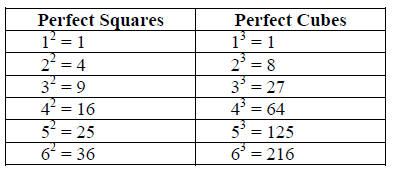
Knowing the perfect squares and cubes will help in simplifying the radicals
when used in conjunction with the product rule for radicals. The product rule of
radicals states that the product of two radicals is equal to the radical of
their product for nonnegative real numbers a and b, and integer n > 1

Note that the indexes on the radicals are not multiplied together. Only the
radicands are multiplied together.
Example 1: Simplify

Solution:
Step 1: Factor 72 as the product of a perfect square and another integer
The largest perfect square that is a factor of 72 is 36

Step 2: Use the product rule for radicals to separate the radical into a product
of
radicals

Step 3: Simplify the radical

Example 2: Simplify

Solution
Step 1: Factor 54x^7 as the product of a perfect cube and another term
The largest perfect cube that is a factor of 54 is 27
The largest perfect cube that is a factor of x^7 is x^6
So our perfect cube will be 27x^6
Which would leave 2x as our other product in the radicand

Step 2: Use the product rule for radicals to separate the radical into a
product of
radicals

Step 3: Simplify the radical
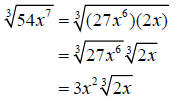
If you are having difficulty reducing the radicals then there is another
method you can use to determine what will come out of the radicand and what will
remain inside. The method involves dividing the exponents of each term by the
index. The quotient will be the exponent of the term that will go outside of the
radicand and the remainder will be the exponent of the term left inside the
radicand.
Let’s use the cube root of 16x17y8 as an example.
First, we will rewrite 16 in its prime factorization form of 24

Now, divide each exponent by the index

The quotients will be the exponents on the terms outside
the radicand and the
remainders will be the exponents inside the radicand.

Last, simplify the exponents.
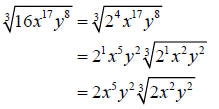
Example 3: Simplify
 using the quotient/remainder method. using the quotient/remainder method.
Solution:
Step 1: Rewrite 125 in its prime factorization form

Step 2: Divide each exponent in the radicand by the
index

Step 3: Place the quotients as exponents outside of the
radicand and the remainders
inside.

Step 4: Simplify

Another rule that will come in assistance when simplifying
radicals is the quotient rule for radicals. Like the product rule, the quotient
rule provides us with a method of rewrite the quotient of two radicals as the
radical of a quotient or vice versa provided that a and b are nonnegative
numbers, b is not equal to zero, and n is an integer > 1.

Example 4: Simplify

Solution
Step 1: Use the quotient rule of radicals to rewrite the problem as the radical
of a
quotient.

Step 2: Reduce the fraction inside the radicand

Step 3: Rewrite 16 in prime factored form
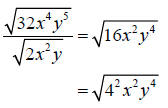
Step 4: Simplify the radical
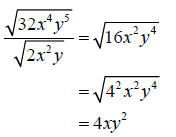
|